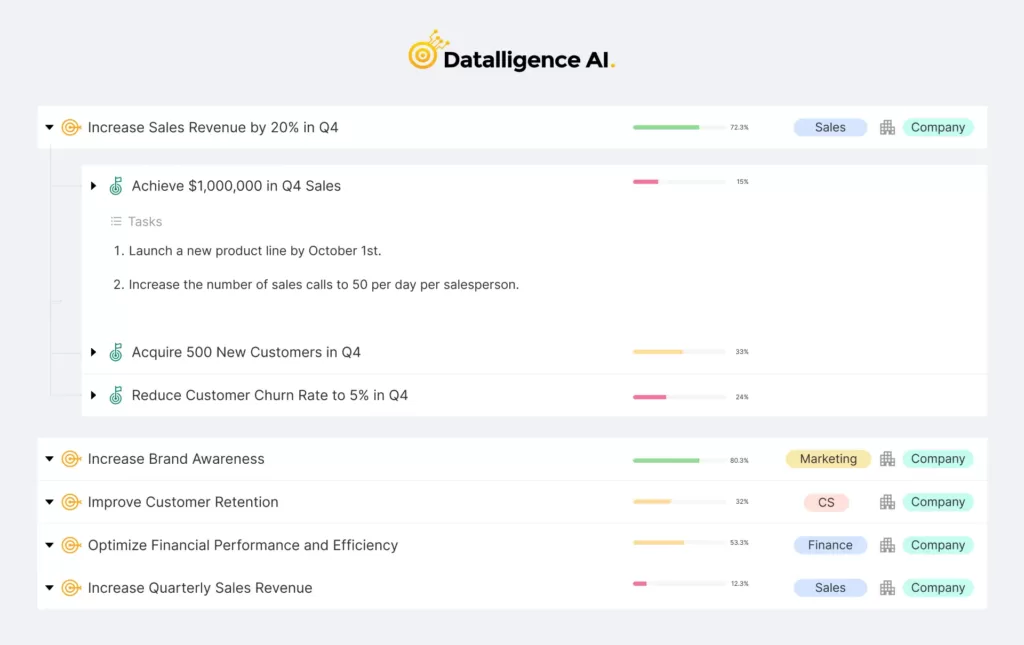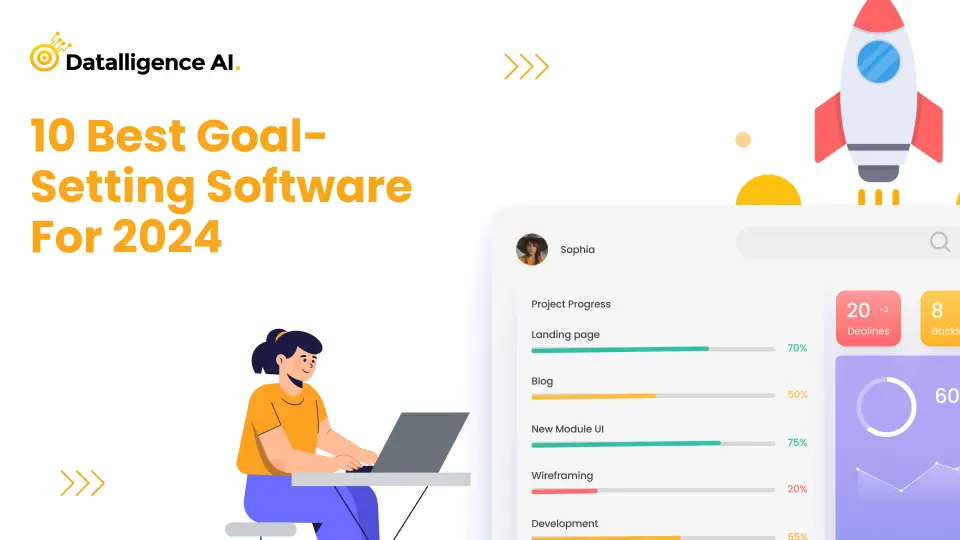In the B2B SaaS ecosystem, Objective and Key Results (OKRs) stand out as pivotal tools. They harmonize team objectives, ensuring that every stride aligns with broader organizational goals. Given the rapid pace of decision-making in SaaS, OKRs become the backbone of enhanced collaboration, clear communication, and heightened customer satisfaction.
Within this framework, B2B SaaS Marketing OKRs are particularly salient. As marketing teams navigate a fluid digital landscape while aligning with sales and product visions, these OKRs act as compasses. They ensure strategies are not only innovative but also lead to measurable growth.
On the customer front, success and retention hold immense weight in the SaaS domain. Products often come with learning curves, and robust user support is crucial. Boosting retention and maximizing user value directly fuel a company’s growth. Metrics like a 10% rise in customer satisfaction or initiatives like targeted webinars can significantly amplify this impact.
5 Best OKR Templates for B2B SaaS Companies
1. Datalligence OKR Templates

Datalligence software is designed to help businesses efficiently adopt, track, and manage their OKRs (Objectives and Key Results). Their template provides a structured approach to OKRs, ensuring alignment, tracking, and results-oriented action.
In the rapidly evolving landscape of SaaS companies, effective goal-setting and outcome-tracking systems like OKR templates are indispensable.
A basic OKR template tailored for SaaS companies might encompass objectives related to product development, customer success, market expansion, and operational efficiency. Key results can quantify the uptake of new features, reduction in churn rates, or milestones in user acquisition.
The inclusion of initiatives ensures that the day-to-day tasks directly correlate with the broader objectives, thus aligning the tactical with the strategic.
Benefits of using such templates include fostering agility in product and feature roll-outs. This ensures that customer feedback translates into actionable improvements, thereby creating a culture of accountability and transparency.
Moreover, as SaaS companies often operate in a dynamic environment, having a structured approach like OKRs, underpinned by tools like Datalligence, facilitates real-time decision-making and promotes alignment with the overarching business strategy.
2. Company OKR Template
This template is geared towards setting and tracking overarching company-wide goals. It provides a bird’s eye view of the company’s objectives and how individual teams or products contribute to the larger vision. Here’s an overview:
Objective: This is a high-level, qualitative goal that the entire company aims to achieve. It encapsulates the broad direction or vision the company is steering towards over a set period, often a quarter or a year.
- Example: Become the leading CRM solution for mid-sized e-commerce businesses.
Key Results: These are specific metrics that will be used to measure progress towards the stated objective. They are quantitative, time-bound, and should ideally be challenging yet achievable.
- Example 1: Onboard 500 new e-commerce businesses in Q2.
- Example 2: Achieve a 95% customer retention rate.
- Example 3: Release three new features tailored for e-commerce pain points.
3. Strategic Marketing Plan Template
This template is designed to help B2B SaaS companies streamline their marketing efforts, ensuring alignment with business objectives and optimizing resource allocation. Here’s a brief overview:
Objective: This provides a high-level qualitative goal tailored specifically for marketing. It sums up what the marketing team aims to accomplish in a specified period.
- Example: Position our SaaS product as the top choice for financial institutions.
Key Strategies: These are broad approaches or methods the team will adopt to achieve the stated objective. They set the direction for the marketing initiatives.
- Example 1: Leverage content marketing to highlight our software’s compliance features.
- Example 2: Forge partnerships with financial influencers for webinars and podcasts.
Tactics: These are specific actions or campaigns aligned with each strategy to realize the objective. They are more granular and actionable.
- Example: Publish a bi-weekly blog post on finance regulatory updates and how our software addresses them.
Metrics/Key Results: Quantifiable measures to track the effectiveness of the strategies and tactics, ensuring alignment with the marketing objective.
Example: Achieve a 20% increase in organic website traffic from financial institutions.
4. OKR Review Template
Positioned as the reflective cornerstone in the OKR journey, the OKR Review Template provides a structured, yet flexible framework for B2B SaaS companies to assess, grade, and draw insights from their performance. The integration of an OKR grading system is what sets it apart, offering quantifiable clarity on achievements and shortfalls. Here’s how it unfolds:
Objective Rewind: A revisit to the original objective, setting the stage for evaluation.
- Example: Attain market leadership in the European SaaS landscape.
Graded Key Results Analysis: Each key result is presented with its planned target, achieved status, and grade. The grading, typically on a scale (like 0.0 to 1.0), reflects the degree of achievement.
- Example 1: Target: Penetrate 3 new European markets. Result: Expanded into 2. Grade: 0.67/1.0.
- Example 2: Target: Host 5 product webinars. Result: Conducted 4 webinars. Grade: 0.8/1.0.
Victories & Valuable Outcomes: Spotlight on the triumphs, underscoring the successful strategies and decisions.
- Example: Our product demo was the most downloaded in Q2 across European B2B SaaS platforms.
Hiccups & Lessons: A candid reflection on the misses and the lessons they imparted.
- Example: Delay in localization for the French market highlighted the need for region-specific planning.
Takeaways & Forward Momentum: Based on graded results and insights, a direction for the next OKR cycle is carved out.
- Example: Prioritize localization and deepen market research for targeted European regions.
4. Kanban for Software Development Template
Kanban, derived from Japanese manufacturing, is a visual tool that aids in managing workflow. When tailored for software development, it becomes a powerful method to visualize tasks, manage backlogs, and ensure efficient product iterations. Here’s an overview:
Objective: The overarching aim for the software development team during a specified period.
- Example: Improve platform stability and user experience.
Columns/States: A typical Kanban board is divided into several columns, representing stages of tasks such as “Backlog, In Progress, “Testing”, and “Done.
Cards/Tasks: Each card on the board represents a specific task or user story. Details such as task description, assignee, and deadlines can be included.
- Example: Optimize the database query for faster report generation.
WIP Limits: Work in Progress (WIP) limits define the maximum number of tasks that can be in a particular state at one time. It ensures that teams don’t overcommit and helps in identifying bottlenecks.
- Example: Only 5 tasks can be in the ‘Testing’ phase simultaneously.
Metrics/Key Results: Metrics to gauge the efficiency of the development process, like lead time, cycle time, or throughput.
- Example: Achieve a cycle time of less than three days for critical bug fixes.
Benefits of Datalligence OKR Templates
- Provides end-to-end OKR management from setting to tracking.
- Ensures OKRs across teams align with overarching company objectives.
- Offers smooth integration with other business tools for efficient operations.
- Promotes collective input and refinement of OKRs across teams.
- Facilitates regular check-ins and performance reviews for continuous improvement.
- Tailors to the specific needs and nuances of B2B SaaS companies.
- Real-time analytics empowers leadership with informed decision-making.
Conclusion
Setting clear objectives and measuring the right key results can be the difference between stagnation and exponential growth for B2B SaaS companies. These OKR templates are designed to cover a broad range of departments and initiatives within your organization, but customization is key. Adapt them to your company’s specific needs, culture, and goals.
Looking for more insights on how to set, track, and achieve your B2B SaaS company’s goals? Talk to us! We have the expertise and experience to guide you on your OKR journey.











